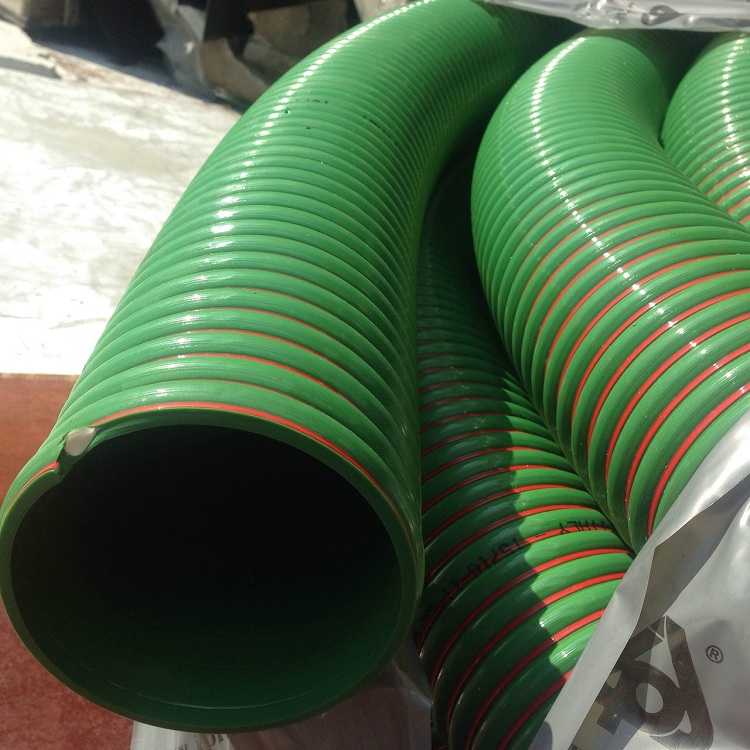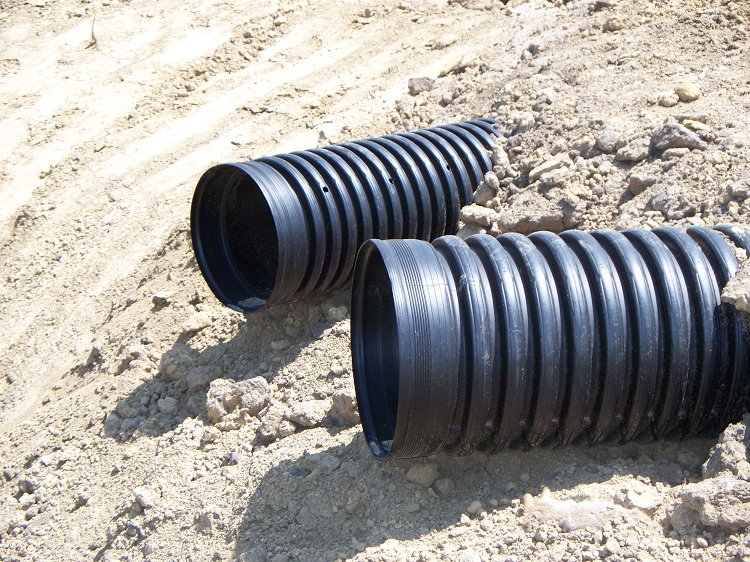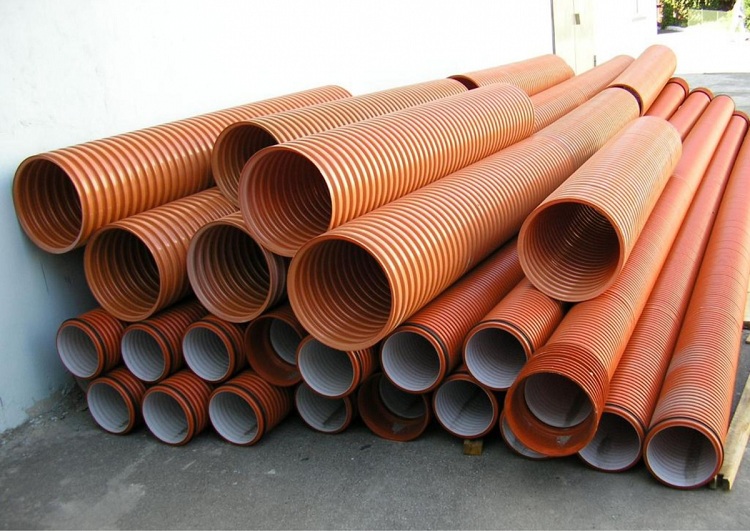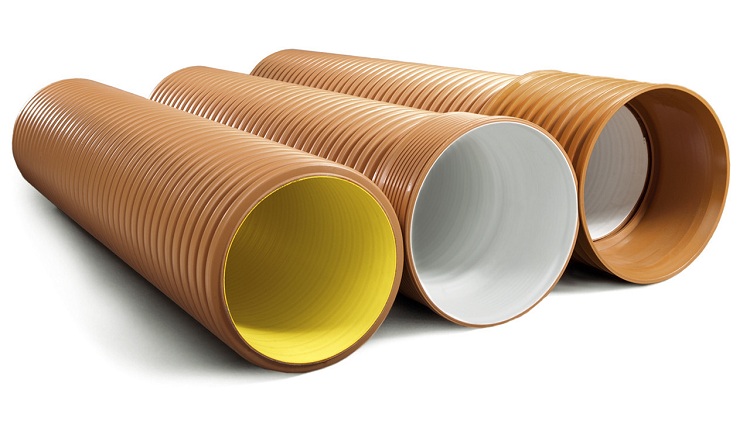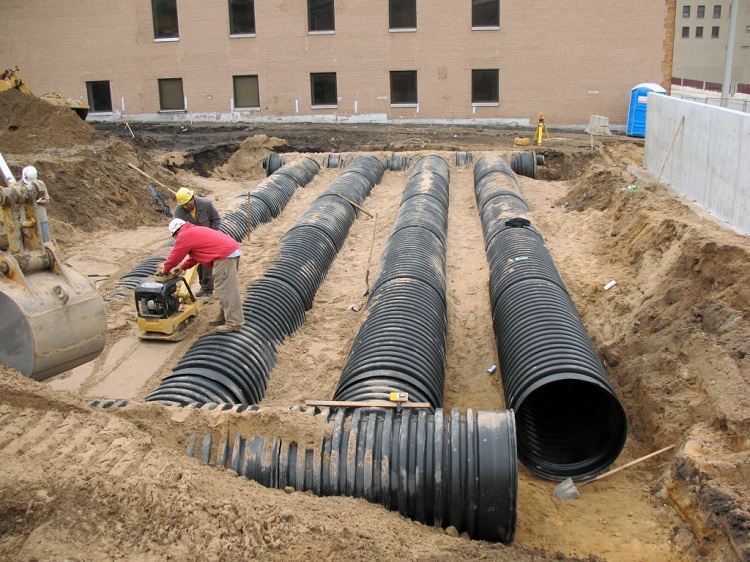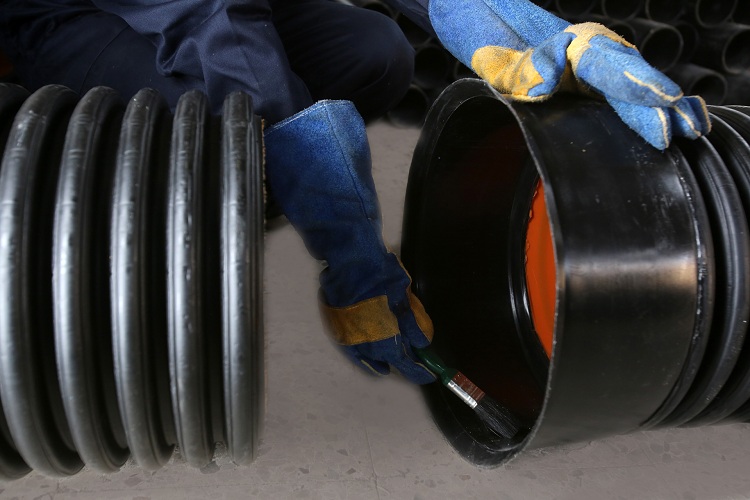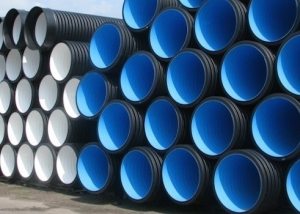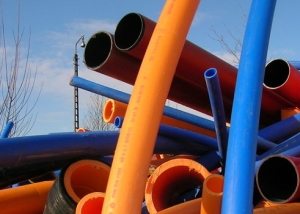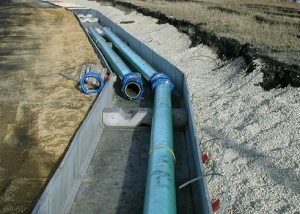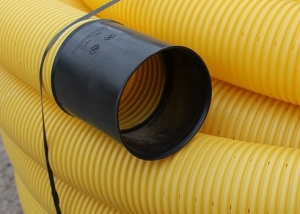Corrugated hose for sewage is a product that is made from polymeric materials and used in the installation of sewer systems (both internal and external). The high flexibility of this device allows you to use it in cases where ordinary pipes cannot be laid, as a rule, in conditions of limited space.
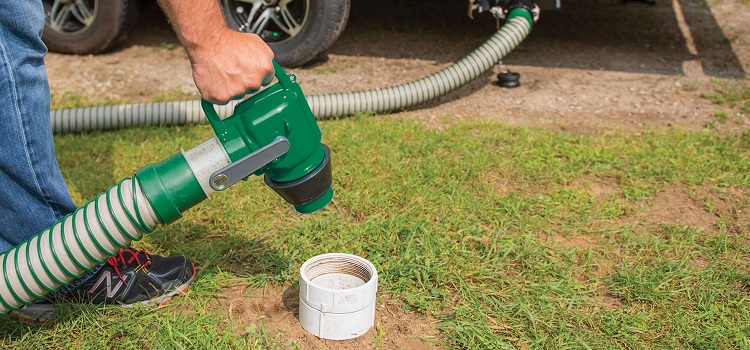
With the help of corrugated hoses, the contents of the sewage system are pumped out, they are also used in all cases where a flexible drainage system is needed
Content
Why are corrugated hoses better than smooth pipes?
The corrugated design allows these pipes and hoses to be flexible, which is a useful property when laying them. In addition, it is worth noting that if the pipes are corrugated, then they have high strength characteristics due to stiffening ribs.
Such pipes often consist of 2 layers:
- external corrugated;
- inner smooth.
There are many companies that manufacture double-layer corrugated hoses. Such hoses are practical and versatile and exclude the use of fittings in various designs.
Note! The weight of corrugated products is less than that of smooth rigid pipes, so the storage, transportation and installation of these devices is simple.
One of the main advantages of corrugated products is the possibility of using it when installing underground sewer communications at great depths. It is also worth noting that the presence of a ribbed surface allows such products to adapt in the soil, which has relief differences.
Consider other advantages of using corrugated hoses for sewage:
- the inner wall of such devices is very smooth, which positively affects the throughput coefficient, and also prevents the occurrence of garbage jams;
- the operational life of such products under normal conditions is about 50 years;
- external communications from corrugated parts do not need grounding, because corrugated pipes are made from a material characterized by dielectric properties;
- such products are quite a budget option, which does not prevent them from being efficient in operation.
Types of corrugated pipe
Today, the range of these products is represented by several varieties that differ in design and purpose. Consider the main types of corrugated pipes:
- Wiring corrugated pipes, which have an average coefficient of flexibility, as well as medium resistance to mechanical stress;
- Single-layer devices. They have a high coefficient of flexibility and, in addition, low weight. They are often used to protect gas communications or when wiring.
- Corrugated double layer hose. They are used for cabling and are characterized by good mechanical stability.
- Two-layer pipes for the installation of sewer communications. They are durable, flexible and resistant to corrosive influences and aggressive chemicals.
It is also worth noting that there are special rubber corrugated hoses that are used to clean cesspools of private areas.
In addition, all corrugated products are divided into 3 types, depending on what loads they are able to carry:
- lungs;
- heavy;
- superheavy.
In the first case, we are dealing with products that are usually installed externally. This is due to the low margin of safety. Heavy corrugated pipes differ in average indicators of mechanical stability, which allows them to be used for underground installation of communications. The third type is considered the most reliable and is used in non-standard conditions (for example, when installing communication under autopanel).
Corrugated Pipe Materials
For the manufacture of corrugated parts, modern polymer materials are used, among which:
- polyvinyl chloride (PVC);
- polypropylene (PP);
- low pressure polyethylene (HDPE).
Products made of polyvinyl chloride are quite popular and are produced by both domestic and Western companies. For laying cables, pipes with a small diameter are used, and for organizing sewer communications underground, pipes with large cross-sectional indicators are used. The weight of polyvinyl chloride corrugated pipe is presented in table No. 1.
Table 1
| Mm | Weight 1 m, kg |
| 1000 | 40,6 |
| 800 | 26 |
| 600 | 15,8 |
| 500 | 11 |
| 300 | 4,4 |
| 200 | 2,3 |
| 160 | 1,3 |
| 110 | 0,6 |
Note! The most popular and widespread diameter of PVC pipes is a diameter of 100 mm. This is due to the fact that such cross-section indicators optimally cope with the tasks set for them in the discharge of wastewater outside private areas.
Corrugated pipes made of polyvinyl chloride, as practice has shown, have high technological characteristics and are able to last a long period without breakdowns. Such pipes are used not only for private purposes, but also at various enterprises. There are two types of such pipes:
- plain corrugated pipe;
- corrugated hose equipped with a special probe (for cable laying).
Pipes made of low-pressure polyethylene can also be called very popular, as they are used for different purposes:
- to protect cable wiring;
- for installation of sewer structures;
- for the arrangement of storm systems.
Differ in small weight and high reliability. They are stored, transported and sold in special coils (bays).
Corrugated products from low-pressure polyethylene are used, as a rule, for the arrangement of external sewer communications. For the installation of a sewer pipeline in a private house, experts recommend the use of corrugated pipes with cross-sectional indicators from 110 to 200 mm. Products made of polyethylene, which are yellow in color, are used at a depth of 15 to 20 meters. Their installation is carried out using additional material, which has dielectric properties. This eliminates the work of arranging grounding. The weight of the corrugated pipe made of polyethylene is shown in table 2.
table 2
| Mm | Weight 1 m, kg |
| 1000 | 40,5 |
| 800 | 24,5 |
| 630 | 17,8 |
| 500 | 12 |
| 315 | 4,6 |
| 200 | 1,8 |
| 160 | 1,5 |
| 110 | 0,9 |
Double-layer corrugated pipes made of polypropylene are highly resistant to corrosion and aggressive chemicals, so they can be used for laying in contaminated soil. Among other advantages of this polymer, it is worth highlighting its resistance to temperature fluctuations.
Corrugated pipes made of PP are resistant to abrasion, therefore, they are popular in the installation of communications, which are located under a slope in different soils. The weight of corrugated pipes made of polypropylene can be found in table No. 3.
Table 3
| Mm | Weight 1 m, kg (SN4, SN8) |
| 1000 | 40,6 |
| 800 | 26–32,5 |
| 600 | 16–20,5 |
| 500 | 11–14,5 |
| 300 | 4,4–5 |
| 200 | 2,3–2,7 |
| 160 | 1,3 |
| 110 | 0,6 |
Corrugated pipes for arranging domestic sewage
When installing sewer communications underground, as a rule, polypropylene corrugated pipes are used, which are characterized by high ductility and flexibility. It is worth noting that the use of corrugated products for underground communications began not so long ago, however, the corrugated pipes have already managed to prove themselves from the best side. The ease of installation and efficiency, as well as the unpretentiousness of maintenance make these products very popular for the arrangement of underground sewer communications.
Smooth rigid pipes used for arranging internal sewer networks are able to withstand heavy loads when falling asleep with soil, and also have excellent temperature variability. Among other things, such tubes are resistant to fire and are capable of transporting a medium whose temperature reaches +800 ° C.
Such internal pipelines are often fixed to the walls, so they must have good rigidity and the ability to maintain their shape even under heavy loads.
Important! Preservation of shape is a very important factor, since usually the sewer system is mounted at a certain slope so that the drains are diverted in a natural way. Sagging the pipeline in this case will lead to disruption of wastewater transport and communication failure.
Of course, corrugated parts are not used for such purposes, however, they are no less important element of communication and are mounted in siphons. This allows you to adjust the level of the hydraulic lock, taking into account the number of plumbing equipment and the length of the horizontal as well as vertical sections of communication.
The most popular indicators of the cross-section of pipes used in the installation of internal sewer systems are 40–110 mm.
Corrugated pipes for outdoor sewage
For installation of external sewer communications, corrugated products from low-pressure polyethylene are most often used. This material is flexible and able to withstand heavy loads. Laying pipelines from HDPE is carried out to a depth of 20 meters.
Such pipes are made in different sizes. Among other things, such pipes are frost-resistant, which allows them to be laid at a shallower depth without fear for their condition during operation. Another advantage corrugated pipe made of low pressure polyethylene - for their installation does not require connecting components - fittings, which significantly saves time and money.
When installing storm sewers, polyvinyl chloride corrugated pipes are often used. Products from this material have ribs that are characterized by high rigidity. Rib stiffness determines the resistance of the product to mechanical stress. Suppliers of these products recommend laying them at a depth not exceeding 20 m.
The nuances of installing corrugated pipes for sewage
Installation of sewer communication using corrugated pipes should be carried out taking into account all norms and rules, as well as safety precautions. Corrugated pipes for sewer systems made of low-pressure polyethylene are laid in trenches (in a closed way).
In order to dock individual structural elements in the sewer system, a special bell-shaped technology is used.Thanks to the bell-shaped pipe connection, installation is carried out at high speed.
Consider the basic rules and recommendations for laying corrugated sewer pipes:
- it is recommended before laying the corrugated pipe in a pre-prepared trench, carefully check it for any damage (holes, cracks, deformations, etc.);
- installation of the corrugated sewer pipe is preferably carried out in the spring. And also allowed the installation of these products in the fall. It is worth noting that laying corrugated sewer pipes at lower or, conversely, elevated temperatures is categorically not recommended, as this can lead to the fact that the corrugated pipe will lose its operational characteristics;
- the ends of the pipes that will be joined together should be well cleaned from burrs and other defects;
- To improve the mechanical strength at the docking point, special o-rings are used.
Corrugation made of modern polymeric materials is an excellent solution for arranging sewer communication in an apartment or private house. Such products have high performance and are used even in non-standard conditions, which indicates their effectiveness and reliability.
Installation Steps
Installation of closed sewer communication is carried out in several stages. Consider them:
- Arrangement of trenches.
- Docking the corrugated pipe together.
- The final stage at which the trench is backfilled.
Important! Before you start digging a trench, it is recommended to read the building codes and regulations (SNiP), which describe in detail how to conduct this event and how to perform the correct slope for the sewer system.
The distance between the corrugated pipe in the ditch and the ground should be at least 20 cm, and the width of the ditch itself should be at least 0.5 m. Also, before laying the corrugation into the trench, it is advisable to audit its bottom and remove all large stones and other debris. After this, you need to fill the sand at the bottom of the trench, which will be a kind of "pillow" for sewage.
Consider the sequence of actions at the stage of pipe connection:
- First of all, all individual corrugated pipes are laid in a trench.
- Before connecting the pipes, it is necessary to clean the socket and inlet end from contamination.
- Further on the second turns of the corrugation, sealing elements (rings) are mounted.
In order to connect a corrugated pipe with a pipe made of another material, it is necessary to use special connecting elements - fittings. Today the assortment of fittings is very wide, including transitional ones, which allow connecting different pipes.
